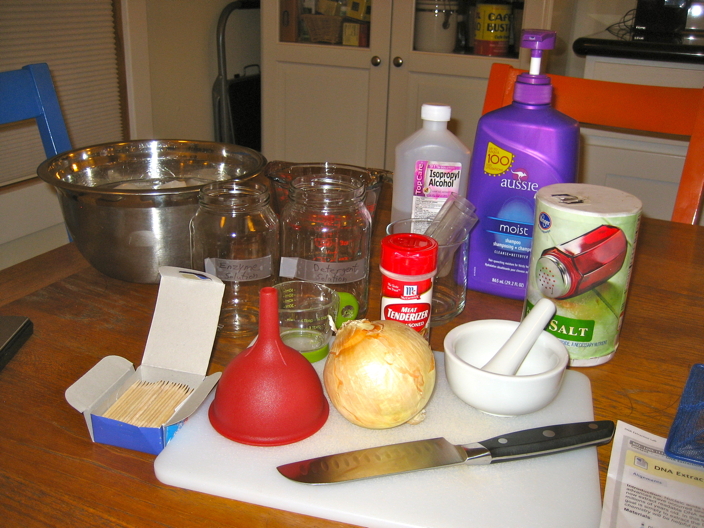
DNA Extraction Lab Setup

DNA Extraction Lab Setup
Materials:
Instructions: Write detailed notes on what you see and do at each step below.
Methods:
1) Obtain a small piece of onion (about 10 cm3) and chop it into tiny cubes (< 1 mm3)
Why? The physical chopping breaks the plant's cell fibrous walls (made of tough cellulose) and allows the cytoplasm to leak out.
2) Place the chopped onion into the mortar and thoroughly grind it with the pestle.
Why? Grinding continues the physical breakdown of the tough cell walls.
3) Add about 10 ml of detergent solution and grind again.
Why the detergent? The soap breaks down the lipids (fats) in the phospholipid bi-layers of the cell membrane and nuclear membrane. This releases the nuclear material from the cell and the chromosomes containing DNA from the nucleus.
4) Filter the mixture through netting into a large test tube.
Why? Filtering strains all the large cellular junk out of the mix. The DNA is so small it slips through with the liquid and into the test tube.
5) Add about 3-4 ml of enzyme solution to the test tube.
Why? The enzymes denature (break down) the histone proteins that were keeping the DNA tightly coiled up on the chromosomes. As a result, the DNA is released and uncoils.
6) Let the mixture stand in a beaker of hot tap water for 10 minutes.
Why? Heat increases the rate of chemical reactions, and speeds the action of the enzymes.
7) Place your test tube in the ice bath to chill for several minutes.
Why? Cooling decreases the rate of chemical reactions, slowing the action of the enzymes before they destroy the DNA.
8) Carefully pour 10 ml ice-cold ethanol into test tube to form a separate layer on top. (You should see small wisps of gel forming at the boundary.)
Why? The polar/non-polar boundry layer causes the DNA to precipitate.
9) Using the bamboo skewer, gently wind up the precipitated DNA. Show it to your instructor to verify that you have the DNA.
Why? The DNA is long and thin so it wraps around the toothpick like spaghetti on a fork!
10) One last question for you. Why didn't all that grinding and chopping destroy the DNA?
The DNA is so small and is coiled up so tightly by the histone proteins that it escapes most of the physical treatment. Once it is released from the histones by the enzyme solution, it unwinds into long strands and becomes much more fragile.